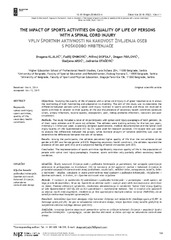Приказ основних података о документу
The impact of sports activities on quality of life of persons with a spinal cord injury
| dc.creator | Kljajić, Dragana | |
| dc.creator | Eminović, Fadilj | |
| dc.creator | Dopsaj, Milivoj | |
| dc.creator | Pavlović, Dragan | |
| dc.creator | Arsić, Slađana | |
| dc.creator | Otašević, Jadranka | |
| dc.date.accessioned | 2021-06-09T14:13:41Z | |
| dc.date.available | 2021-06-09T14:13:41Z | |
| dc.date.issued | 2016 | |
| dc.identifier.issn | 0351-0026 | |
| dc.identifier.uri | http://rfasper.fasper.bg.ac.rs/handle/123456789/984 | |
| dc.description.abstract | Objectives. Studying the quality of life of people with a spinal cord injury is of great importance as it allows the monitoring of both functioning and adaptation to disability. The aim of this study was to determine the difference between persons with a spinal cord injury involved in sports activities and those not involved in sports activities in relation to their quality of life and the presence of secondary health conditions (pressure ulcers, urinary infections, muscle spasms, osteoporosis, pain, kidney problems-infections, calculosis and poor circulation). Methods. The study included a total of 44 participants with spinal cord injury-paraplegia of both genders; 26 of them were athletes and 18 were not athletes. The athletes were training actively for the last two years, minimally 2-3 times per week. A specially designed questionnaire, medical documentation and the Spinal Cord Injury Quality of Life Questionnaire (SCI QL-23) were used for research purposes. Chi-square test was used to analyze the differences between the groups, while multiple analysis of variance (MANOVA) was used to determine the differences between the sets of variables. Results. Among the participants, the athletes perceived higher quality of life than the non-athletes (male gender p lt 0.001 and female gender p lt 0.05). Regarding secondary health conditions, the athletes reported the presence of less pain (p=0.034) and a subjective feeling of better circulation (p=0.023). Conclusion. The implementation of sports activities significantly improves quality of life in the population of people with spinal cord injury-paraplegia. However, sports activities only partially affect secondary health conditions. | en |
| dc.publisher | Inst Public Health Republic Slovenia, Ljubljana | |
| dc.relation | info:eu-repo/grantAgreement/MESTD/Integrated and Interdisciplinary Research (IIR or III)/47015/RS// | |
| dc.rights | openAccess | |
| dc.source | Zdravstveno Varstvo | |
| dc.subject | spinal cord injury | en |
| dc.subject | sports activities | en |
| dc.subject | quality of life | en |
| dc.subject | secondary health conditions | en |
| dc.title | The impact of sports activities on quality of life of persons with a spinal cord injury | en |
| dc.type | article | |
| dc.rights.license | ARR | |
| dc.citation.epage | 101 | |
| dc.citation.issue | 2 | |
| dc.citation.other | 55(2): 94-101 | |
| dc.citation.rank | M23 | |
| dc.citation.spage | 94 | |
| dc.citation.volume | 55 | |
| dc.identifier.doi | 10.1515/sjph-2016-0014 | |
| dc.identifier.fulltext | http://rfasper.fasper.bg.ac.rs/bitstream/id/843/981.pdf | |
| dc.identifier.pmid | 27284378 | |
| dc.identifier.scopus | 2-s2.0-84962132815 | |
| dc.identifier.wos | 000378530100002 | |
| dc.type.version | publishedVersion |


